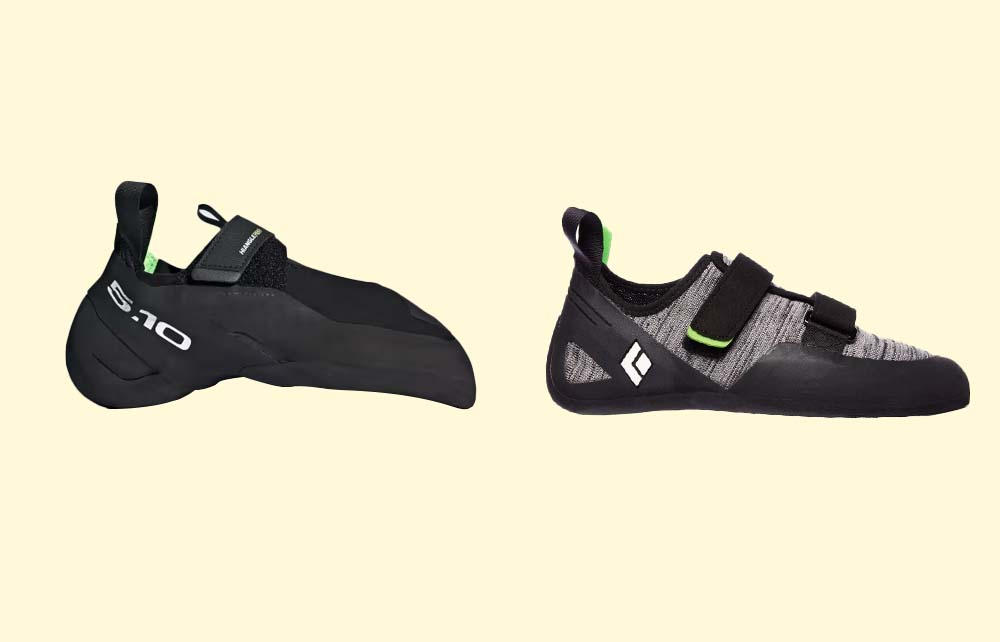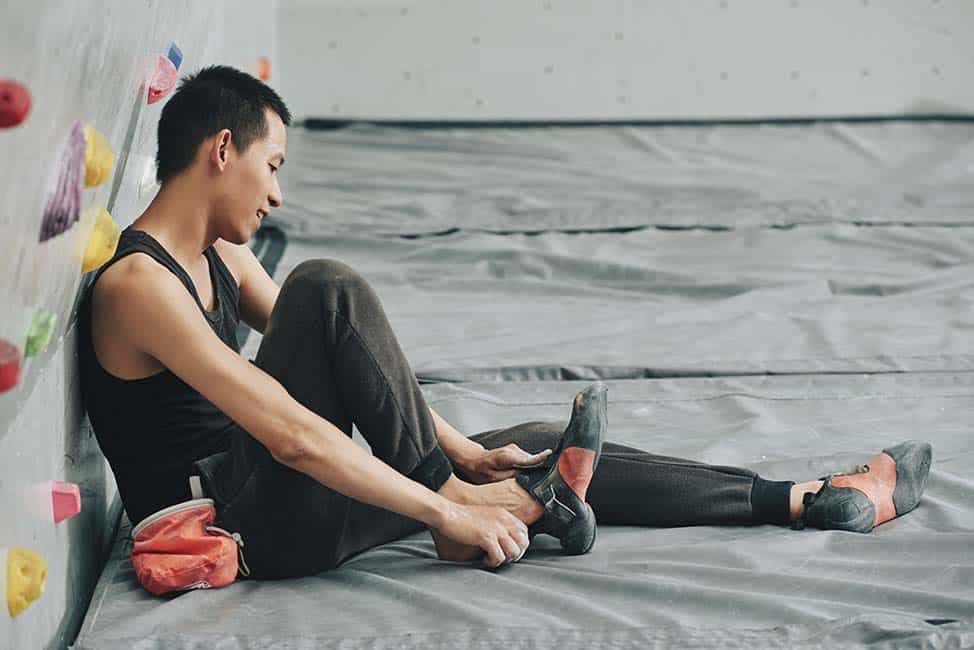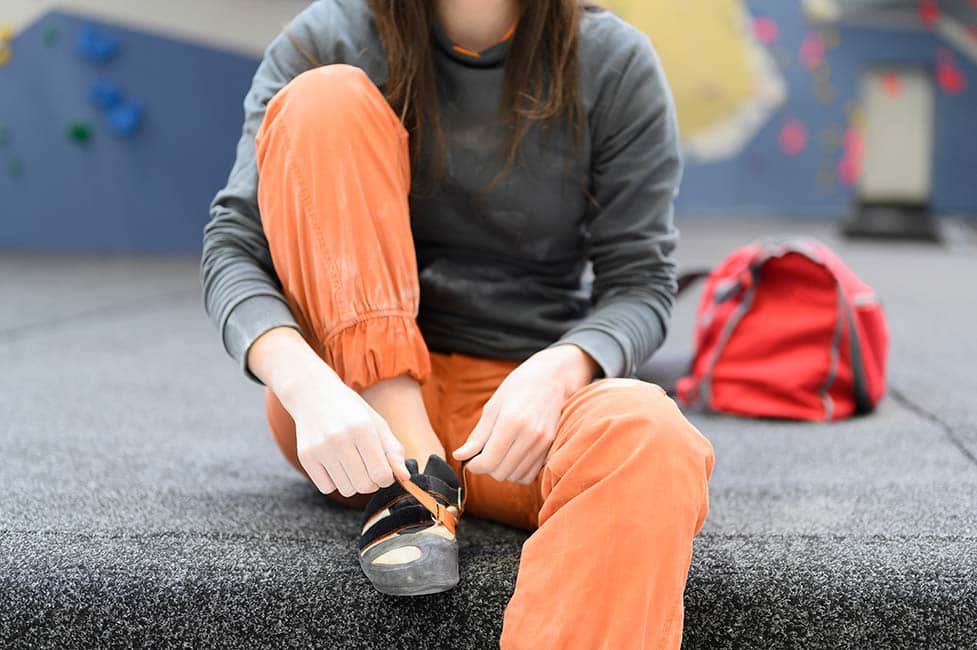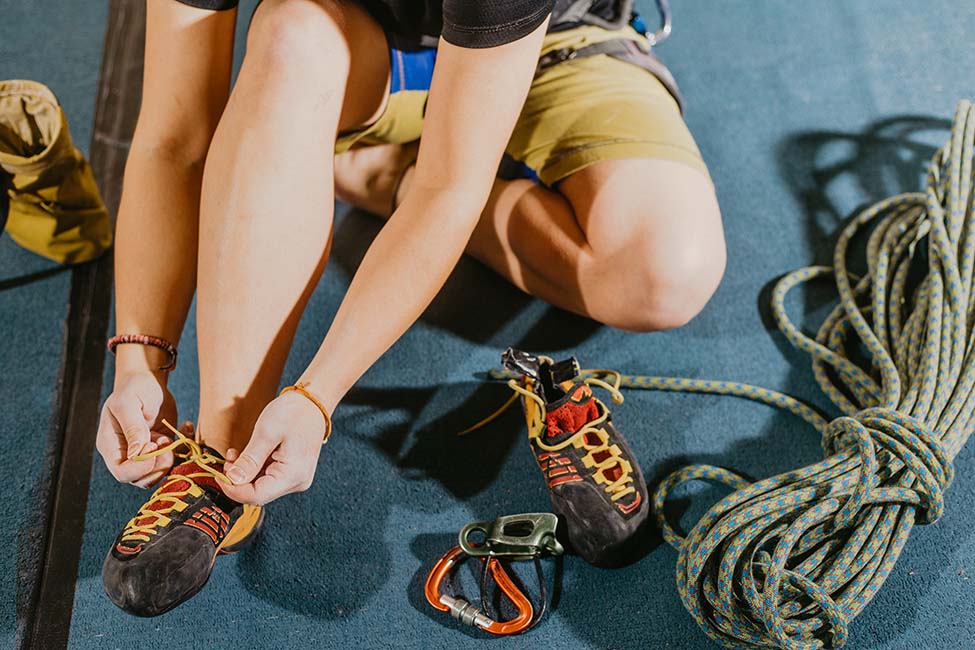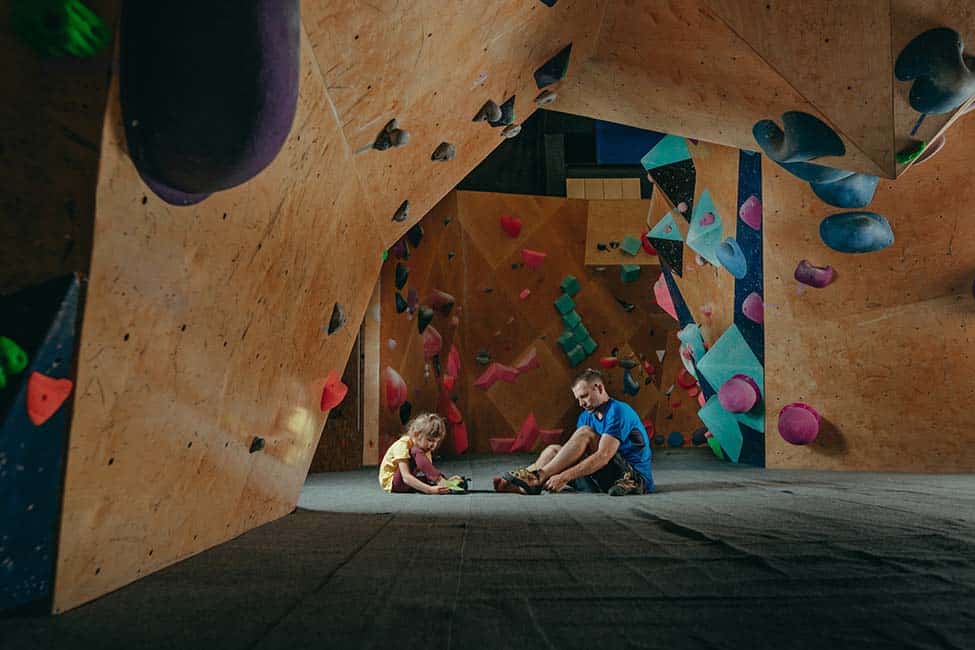Climbing shoes are one of the most important pieces of climbing equipment rock climbers rely on. That’s because climbing shoes are responsible for being the direct connection between your feet and the stone.
For your climbing shoes to help you perform the best, you need to ensure that your climbing shoes fit correctly. That’s why climbing shoe sizing is such an essential topic to discuss.
So, if you are new to climbing and purchasing your first pair of climbing shoes or have been unhappy with how your shoes fit and want to make an adjustment, keep reading.
In this article, I will talk about climbing shoe sizing and share my opinions about how I think you should select your next pair of shoes.
Types of Climbing Shoes
The sheer quantity of climbing shoes you can choose from can be overwhelming. So to help you begin thinking strategically about what types of shoes are on the market and which ones may suit you the best, I want to help you organize the options.
To do so, it’s helpful to think about three things.
- The level of your climbing skill or experience
- The shoe’s profile
- The shoe’s shape
|
Climbing Level
|
Shoe Profile | Shoe Shape |
|---|---|---|
| Beginner | Flat/Neutral | Low asymmetry |
| Intermediate | Slightly downturned | Medium asymmetry |
| Advanced | Agressively downturned | High asymmetry |
Symmetrical vs. Asymmetrical Climbing Shoes
In the past, most climbing shoes were manufactured with a somewhat symmetrical shape. However, nowadays, most climbing shoes come with at least some asymmetry which impacts the climbing shoe sizing required.
Regarding asymmetry, climbing shoes come in three levels– low, medium, and high asymmetry.
An asymmetrical shape in climbing shoes helps create tension. Tension is critical for gripping the rock with your toes, especially in steep or overhung terrain.
In addition, the asymmetrical shape positions the tip of the shoe’s tow box directly over your big toe. That’s because your big toe is the strongest and the most important for edging.
Neutral vs. Downturned Climbing Shoes
The other important characteristic of climbing shoes to consider is how flat or downturned their profile is. Similar to asymmetry, climbing shoes are designed with one of three types of downturn– flat or neutral, slightly downturned, or aggressively downturned.
In a neutral climbing shoe, your feet lay flat. Typically, neutral climbing shoes are the most comfortable and closest to your normal street shoe size.
However, in an aggressively downturned shoe, your feet are forced into a hooked, talon-like position. This hooked position flexes your foot into a stronger position and helps focus all your power on a specific area of the toe box.
In most cases, aggressive climbing shoes are sized smaller than street shoes because you want your toes to be slightly bent in the toe box. Having bent toes flexes them into a stronger, higher performing (albeit more uncomfortable) position.
The extent to which they’re downturned will therefore affect the climbing shoe sizing you need.
Soft vs. Stiff Climbing Shoes
Deciding between soft and stiff climbing shoes is a matter of personal preference. But it’s also worth considering the terrain your most often climb. For example, steep climbing on small edges calls for stiffer shoes, while smearing calls for softer shoes.
Soft shoes tend to be more sensitive. That’s because the outsole rubber tends to be thinner. This translates to feeling more of the rock beneath your toes.
Soft shoes are also more flexible. Flexible shoes perform better on smears because they help you create more surface contact and friction between the shoe’s outsole and the rock.
On the other hand, stiff shoes tend to be more stable. Typically, stiffer shoes have harder, thicker, and more durable rubber in the outsole. This means you have a stronger platform beneath your toes for standing on small edges.
Climbing Shoe Sizing
There are a lot of opinions when it comes to sizing climbing shoes. However, what’s most important is prioritizing how the shoes fit and feel on your feet instead of someone else’s opinion.
And with that said, here are some of my opinions about sizing climbing shoes based on my background as a recreational climber, climbing coach, and climbing guide.
The General Trend is to Size Down
In most cases, climbers wear climbing shoes in smaller sizes than their everyday street shoes. How much someone sizes down is a personal preference.
However, for the most part, I’d say it’s common for climbers to size their climbing shoes anywhere from ½ size to two sizes smaller.
The reason rock climbers size their climbing shoes smaller than their street shoes is that climbing shoes are built primarily for performance and not necessarily for all-day comfort.
Does Sizing Down Really Make a Difference?
Yes, I do believe that sizing climbing shoes so that they fit tightly to your feet makes a positive difference in the shoe’s performance. But that does not mean I support smashing your feet into climbing shoes that are three or four sizes too small.
Climbing shoes perform better when they fit your feet tightly because they can more effectively become a seamless extension of your feet. In other words, when tight, they feel more precise, can stand on smaller edges, and provide more sensitivity.
On the other hand, when climbing shoes are too big, they feel clumsy or sloppy and insensitive. This is particularly noticeable when you try to stand on small edges in ill-fitting climbing shoes. In general, everything feels less confidence-inspiring.
Things to Consider For Climbing Shoe Sizing
When it comes to sizing your climbing shoes correctly, there is no end-all-be-all or silver bullet to solve all your problems. Instead, there are various items to remember to ensure that you end up with a pair of shoes that fits you well and helps you climb your best.
-
- Some climbing shoes stretch: depending on the shoe’s material, it may stretch. So remember to consider material stretch as you try to decide on a size. This is particularly important for shoes made with leather. On the other hand, shoes constructed with synthetic materials tend to stretch less.
-
- The “type” of climber you are: climbing shoes tend to reflect their owners. If you are a laidback climber, you’ll probably prefer shoes you can somewhat comfortably wear. On the other hand, if you are a high-performing, competitive climber, you’ll prefer shoes that can keep up.
-
- The “type” of climbing you prefer: climbing shoes are purpose-built tools. Some are designed specifically for indoor bouldering whilst others are for multi-day big wall ascents. In other words, climbing shoe manufacturers design climbing shoes with specific characteristics to perform in specific terrain. So, if you like climbing overhung terrain, avoid neutral climbing shoes and stick with aggressively asymmetrical and downturned shoes that help you toe down onto climbing holds and heel or toe hook.
-
- There can be side effects to climbing shoes that are too small: as I said, the general trend is to size your climbing shoes smaller than your street shoes. However, be careful– sizing your shoes too small can lead to chronic pain and injury. If your feet consistently cramp, develop blisters, or lose circulation, your climbing shoes are probably too tight.
-
- Brand loyalty is normal: there are a lot of different climbing shoe brands on the market. And each designs climbing shoes differently. Therefore, if you find a brand that continually fits your feet well, no matter the model of shoe you try out, it’s normal to stick with a single brand and repetitively order new shoes as your old ones wear out.
-
- Size your climbing shoes without socks: unlike street shoes, you want to size your climbing shoes without accommodating socks. That’s because climbing shoes are designed to be worn without socks. However, everyone is different, and if you prefer to climb with socks, that’s perfectly okay.
Closure Systems Matter for Climbing Shoe Sizing
Regarding closure systems for climbing shoes, you have two options– velcro or lace-up. Deciding which one you prefer is critical for ensuring that your shoes fit correctly and help you climb.
Velcro closure systems are super simple yet secure. Velcro makes getting into and out of your climbing shoes much easier. However, to get the right fit, you may be somewhat limited in the amount of tension the velcro closure system can provide.
On the other hand, laces can be slightly more work. However, lace-up closure systems are nice because they run the entire length of the shoe. This allows you to make micro-adjustments and get a super custom and snug fit.
Regardless of which closure system you prefer, what you want to avoid is sizing your climbing shoes large enough so that eventually, as they break in and stretch out, you become unable to properly secure your feet inside despite having the laces tied tightly or the velcro fully strapped.
Breaking in New Climbing Shoes
The break-in process for climbing shoes will vary based on the shoe you selected and how you sized them. In my experience, it’s rare that I buy a new pair of climbing shoes and not experience some general discomfort as I break them in.
However, normally, the slight discomfort fades away after a couple of climbing sessions as my feet adjust to the new shoes and as the shoe materials transform to accommodate my feet.
If you feel like you’re still breaking in a new pair of climbing shoes after a couple of weeks, I might argue that you’ve chosen too small of a size. Or that specific shape or type of shoe cannot (and probably will not) accommodate your feet.
To help you with the break-in process, here are some tips.
- Wear your new shoes at home for short periods as you relax, watch TV or read a book. This will give time for your feet to get used to the new environment without too much stress. This may look silly, but I have found it to be helpful.
- If you’ve chosen a particularly small size, wrap your feet in the packing paper that came with the shoes (or a plastic bag) to reduce the friction and help your feet slip inside.
- With new shoes, keep the velcro straps or laces slightly looser. Then tighten them as the shoes break in. Over time, you want your shoes to fit slightly loose but still snug without tensioning the closure system. Then, with the closure system tightened, they should fit and feel secure.
- Bring sandals to the gym or the crag so you can take breaks and are not confined to your climbing shoes the entire session. Plus, this will help preserve the rubber on the outsole and contribute to your shoe’s longevity.
Depending on where you seek out advice for breaking in climbing shoes, you may read about additional tactics that involve you wearing your climbing shoes during a hot shower. Or stretching your shoes by placing ziplock bags of water inside them and freezing them.
Whether or not these tactics work is kind of up for debate. So, in my opinion, it’s best to keep things simple and simply wear your shoes during climbing sessions and persevere through the initial discomfort.
Final Thoughts on Climbing Shoe Sizing – Should Climbing Shoes Hurt?
No, I don’t believe that climbing shoes should hurt your feet when you wear them.
If your feet are in pain while climbing, that probably means you are focusing less on the climbing movement, problem-solving, and decision-making and more on wanting to come down.
With that being said, however, I do believe that a certain level of discomfort is acceptable, especially during the break-in period of new climbing shoes. That’s because I think a little discomfort from your climbing shoes fitting tighter than you are used to with street shoes is normal. And is part of getting climbing shoes to perform reliably in the long run.
So, if you need to, wear your new shoes for short periods, take breaks from wearing them, and slowly break them in over time until they can fit tightly like a glove without causing you chronic pain.




